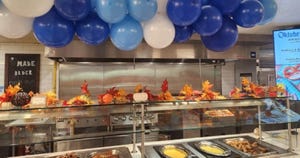
Culinary Council helps identify on-trend menu ideas and operational strategies.
How salad bars evolve to fit diners' desires
April 14, 2017
Question:
How has your salad bar evolved to fit diners’ desires and seasonality?
Answers from FSD's Culinary Council
At Cal Dining, we:
Have composed salads (grab-and-go) featuring local and seasonal ingredients.
Are making videos on how to build your own salad that students can watch online and then make their own creation at a dining hall based on what’s available at the salad bar, plus ingredients from other stations.
Are showcasing make-your-own quinoa bowls at the salad bar; we give students ideas on how to build them with instructions and a sample plate.
Feature a local salad bar as an action station twice per menu cycle, where students can have their salad built by a chef. It’s for diners who want to be pampered and still make a healthy decision.
—Jose Martinez
Senior Executive Chef, Cal Dining
University of California at Berkeley
Our dietitians charged us around two years ago to cut mayo and salad dressings by one-third in our recipes for certain salads like tuna and potato. We have made these changes with no loss in quality, and had the added bonus of lowering calories, fat and sodium.
When it comes to seasonality, we purchase produce like lettuce, peppers, tomatoes and radishes from our student farm on campus and happily serve it to our students as often as it is available. We advertise at the point of service that it is local and from our student farm.
The reason I am so excited about salad bars and produce is that we are in the Midwest, and the expectation is that we do not have access to or serve a large variety of fresh produce—and this is far from the truth. Through partnerships, innovation and a genuine care for our students’ experience, we are able to provide them beautiful, fresh, local produce on our salad bars.
—Carrie Anderson
Executive Chef
University of Illinois at Urbana-Champaign
About the Author
You May Also Like




